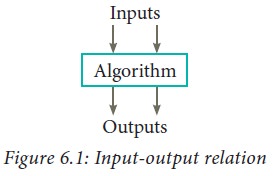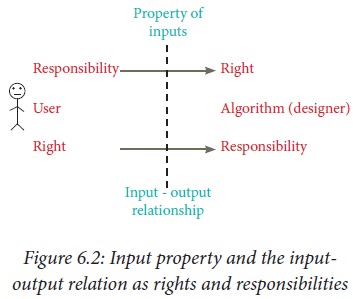Computer Science - Specification | 11th Computer Science : Chapter 6 : Specification and Abstraction
Chapter: 11th Computer Science : Chapter 6 : Specification and Abstraction
Specification
Specification
To solve a problem, first we must
state the problem clearly and precisely. A problem is specified by the given
input and the desired output. To design an algorithm for solving a problem, we
should know the properties of the given input and the properties of the desired
output. The goal of the algorithm is to establish the relation between the
input and the desired output.

An algorithm is specified by the
properties of the given input and the relation between the input and the
desired output. In simple words, specification of an algorithm is the desired
input-output relation.
The inputs and outputs are passed
between an algorithm and the user through variables. The values of the
variables when the algorithm starts is known as the initial state, and the
values of the variables when the algorithm finishes is known as the final state.
Let P be the required property of
the inputs and Q the property of the desired outputs. Then the algorithm S is
specified as
1. algorithm_name
(inputs)
2. inputs
: P
3. outputs:
Q
This specification means that if
the algorithm starts with inputs satisfying P, then it will finish with the
outputs satisfying Q.
A double dash -- indicates that
the rest of the line is a comment. Comments are statements which are used to
annotate a program for the human readers and not executed by the computer.
Comments at crucial points of flow are useful, and even necessary, to
understand the algorithm. In our algorithmic notation, we use double dashes (—)
to start a comment line. (In C++, a double slash // indicates that the rest of
the line is a comment).
Example 6.6. Write the specification of an algorithm to compute the
quotient and remainder after dividing an integer A by another integer B. For
example,
divide (22, 5) = 4, 2
divide (15, 3) = 5 , 0
Let A and B be the input
variables. We will store the quotient in a variable q and the remainder in a
variable r. So q and r are the output variables.
What are the properties of the
inputs A and B?
1. A
should be an integer. Remainder is meaningful only for integer division, and
2. B
should not be 0, since division by 0 is not allowed.
We will specify the properties of
the inputs as
— inputs: A is an integer and B ≠ 0
What is the desired relation
between the inputs A and B, and the outputs q and r?
1. The two outputs q (quotient)
and r (remainder) should satisfy the property
A = q X B + r, and
2. The remainder r should be less
than the divisor B,
0 ≤ r < B
Combining these requirements, we
will specify the desired input-output relation as
— outputs: A = q X B + r and 0 < r < B.
The comment that starts with —
inputs: actually is the property of the given inputs. The comment that starts
with — outputs: is the desired relation between the inputs and the outputs. The
specification of the algorithm is
1. divide (A , B)
2. -- inputs: A is an integer and B ≠ 0
3. -- outputs : A = q X B + r and 0 ≤ r < B
Specification format: We can write the specification in a standard three
part format:
• The
name of the algorithm and the inputs.
• Input:
the property of the inputs.
• Output:
the desired input-output relation.
The first part is the name of the
algorithm and the inputs. The second part is the property of the inputs. It is
written as a comment which starts with — inputs: The third part is the desired
input-output relation. It is written as a comment which starts with — outputs:.
The input and output can be written using English and mathematical notation.
Example 6.7. Write the specification of an algorithm for computing the square
root of a number.
1. Let
us name the algorithm square_root.
2. It
takes the number as the input. Let us name the input n. n should not be
negative.
3. It
produces the square root of n as the output. Let us name the output y. Then n
should be the square of y.
Now the specification of the
algorithm is
square_root(n)
-- inputs: n is a real number, n ≥ 0.
-- outputs: y is a real number such that y 2= n.
Specification as contract
Specification of an algorithm
serves as a contract between the designer of the algorithm and the users of the
algorithm, because it defines the rights and responsibilities of the designer
and the user.
Ensuring that the inputs satisfy
the required properties is the responsibility of the user, but the right of the
designer. The desired input-output relation is the responsibility of the
designer and the right of the user. Importantly, if the user fails to satisfy
the properties of the inputs, the designer is free from his obligation to
satisfy the desired input-output relation.

Example 6.8. Consider the specification of the algorithm square_root.
square_root(n)
-- inputs: n is a real number, n ≥ 0.
-- outputs : y is a real number such that y2 = n.
The algorithm designer can assume
that the given number is non-negative, and construct the algorithm. The user
can expect the output to be the square root of the given number.
The output could be the negative
square root of the given number. The specification did not commit that the
output is the positive square root. If the user passes a negative number as the
input, then the output need not be the square root of the number.
Related Topics